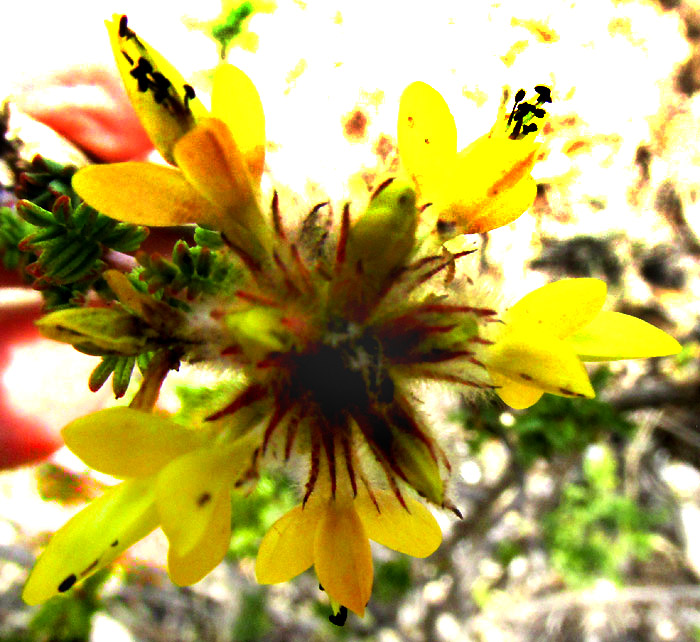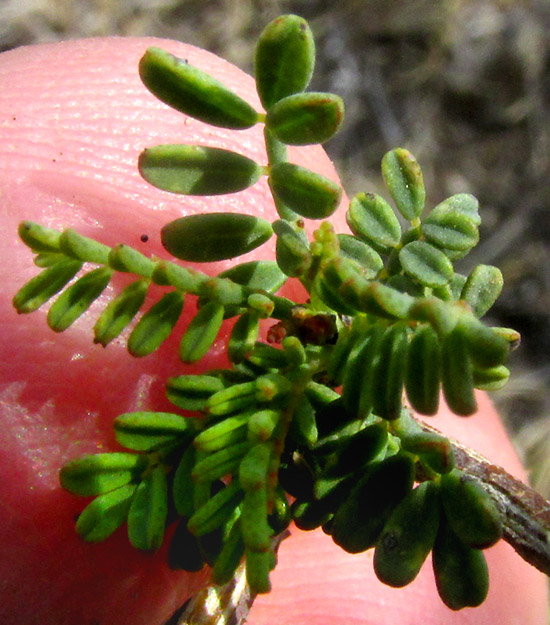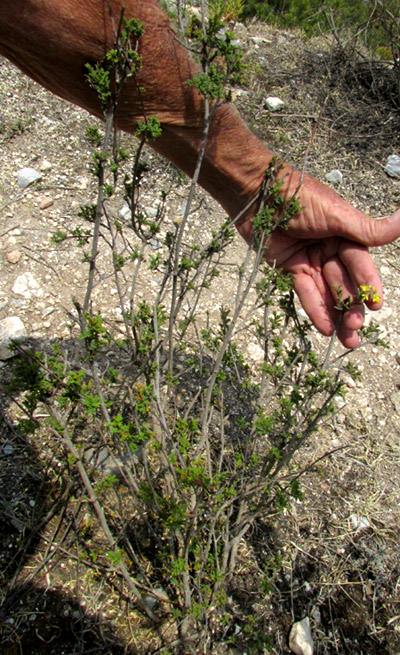Excerpts from Jim Conrad's
Naturalist Newsletter
entry from field notes dated May 4, 2023, taken about 150m uphill on NE-facing slope, above intersection of road from Hwy 120 to San Joaquín, with road to El Doctor; juniper and pine forest on limestone bedrock; elevation ±2425m (7950 ft); Eastern Sierra Madre mountains of east-central Querétaro state, MÉXICO, (N20.88°, W99.62°)
DALEA MELANTHA

Beside a steep trail up a drought-parched, sheep-overgrazed slope, the above cluster of flowers atop a scraggly, knee-high bush caught my eye, despite the whole cluster hardly being bigger than a thumbtip; the yellowness was a detonation of color amid all the bleached gray and brown.
 Within the inflorescence the flowers radiated in all horizontal directions, and were even more attention-getting when seen from above, as seen at the right
Within the inflorescence the flowers radiated in all horizontal directions, and were even more attention-getting when seen from above, as seen at the right
Blossom structure indicates that the plant is a member of the huge Bean Family. The flowers are bilaterally symmetrical, the corollas with a top petal, the standard or banner, directed upward, two side petals called wings, and two lower petals joined along their common margins, forming a scoop-shaped "keel." Such corolla arrangement is said to be "papilionaceous," and is typical of the Bean Family subfamily the Papilionoideae. Filaments of the ten stamens in each flower are fused together at their bases, and are of different lengths, with some curving upwards more than the others, all exactly right for that subfamily. What's a little unusual is that the top standard petal is relatively short, while the bottom keel is relatively long. The flowers present, like inbred Habsburg royalty, receding brows and out-jutting chins.


The vast majority of the Bean Family's species produce compound leaves -- blades divided into subdivisions or leaflets. Our bush's leaves -- as shown at the right, new ones clumped at the stem tips in anticipation of rains and a new growing season -- were small, and once pinnately compound, with up to a dozen or so leaflets. Especially on leaflets at the above picture's left edge, notice that some of the leaflets at their tips bear tiny wartlike, pointy-tipped glands. Obscure as that feature is, it's a good field mark.
In this part of upland central Mexico, if you have a wild member of the Bean Family with papilionaceous flowers, leaflet margins are smooth without any tiny teeth, leaves bear small, pointed glands, the 5 or more leaflets arise on short stalks or petiolules, and the bushy, erect stems are at least semi-woody, the best bet is that you have the big genus Dalea, of which 35 or so species occur in this region.
If your Dalea is clearly a perennial with yellow flowers and the leaflets are less that 5mm long (1/5inch) and number 7 to 13, like ours, you have DALEA MELANTHA.
Dalea melantha is endemic just to Mexico, from the northeastern states southward in the uplands into Oaxaca. It's described as a variable or polymorphic species frequent to sometimes abundant in grasslands and oak woodlands, and may flower anytime of the year. It's known by no English name, though in our area it's sometimes called engorda cabra, or "goat fattner," and escobilla, or "broom," showing that both goats and people have found the plant useful.
Dalea species often are called prairie-clovers. Mexico is the center of diversity for the prairie-clovers, so here Dalea is a good genus to know, if only for the aesthetic buzz experienced by meeting its many "variations on the Dalea theme."
For example, among those we've encountered there's been a species with similar stems and leaves but blue and white flowers, Dalea dorycnioides. A dwarf, herbaceous one with similar yellow flowers was Dalea rubescens. One so sparse and slender it hid amid tall grass, was Dalea aurea. A prairie-clover with tiny yellow and violet flowers was Dalea versicolor. One that lay on the ground and produced long-hairy leaves with only three leaflets was Dalea prostrata. One with obscure, violet flowers on long, arching stems was Dalea scandens.
When Nature discovered the Dalea theme, it's clear She'd found something She could have some fun with.